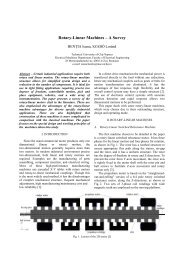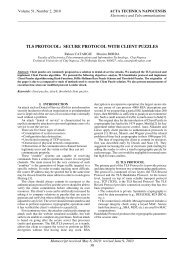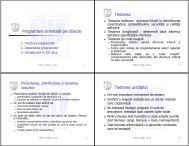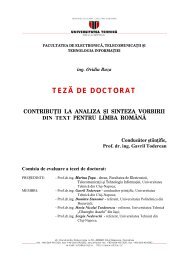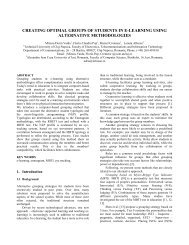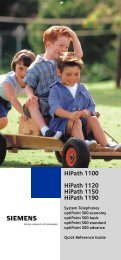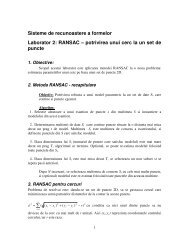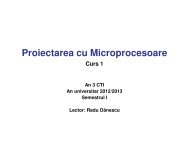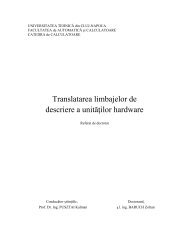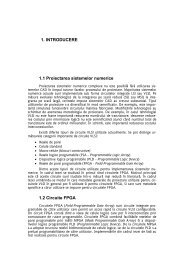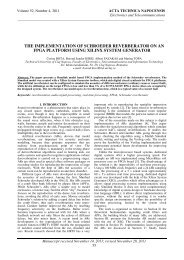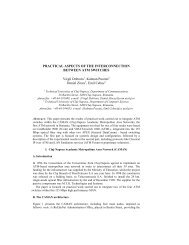LTE Emulator
LTE Emulator
LTE Emulator
You also want an ePaper? Increase the reach of your titles
YUMPU automatically turns print PDFs into web optimized ePapers that Google loves.
TUCN – Data Transmission Laboratory<br />
4. The parameters of the <strong>LTE</strong> simulator<br />
Two categories of users (mobile stations) are considered in the simulations that provide the<br />
statistics which are employed by the emulator:<br />
o one main user, for which the simulation is actually performed;<br />
o a group of secondary users, which makes up the loading of the cell carrier;<br />
The delay (bit rate) and error-probability statistics are built up only for the main user, by<br />
performing in the simulator all the operations (processing) included in the transmission chain.<br />
For the secondary users, the simulator performs only the processing required by the<br />
generation of the characteristic of the radio channel and those involved in the allocation of the<br />
radio resources, which affects the allocation of the radio resources for the main user who is<br />
actually emulated; this approach allows the simulation of the effect of the cell-carrier loading.<br />
The description of the processing performed for the two types of users requires a previous<br />
definition of the data structures employed in the transmission process, the specification of the<br />
modulation and coding techniques employed, the definition of parameters that characterize the<br />
cell and the specification of the parameters that individually define each user.<br />
4.1. Parameters that characterize the cell in the simulation process<br />
The parameters that characterize the cell are defined in a distributed manner between the<br />
simulator and the emulator, as shown in chapter 3. which describes the operating principle of the<br />
emulator.<br />
This way of defining the parameters is employed to reduce as much as possible the number<br />
of simulations, and implicitly the number of statistics-files, required to perform the emulation;<br />
this approach ensures also a reasonable amount of processing performed by the emulator. To<br />
accomplish this goal, the simulator makes use only of the parameters that are independent of the<br />
cell-geometry and of the base-station characteristics; this approach allows for the employment of<br />
the statistics delivered by a simulation in more emulations.<br />
In the simulation process, the cell is practically characterized by:<br />
o the number of active users;<br />
o the multipath propagation profile of the channel;<br />
o the radio-channel carrier frequency (cell-carrier);<br />
o the parameters of OFDM modulation;<br />
o the probability density function of the fast-fading inserted by the users’ motion;<br />
The limits of SNR domain of the signal received by the main user and the limit-values of the<br />
attenuation of the signal received by the secondary users also describe, in an indirect manner, the<br />
cell employed in the simulation process. All the above parameters can be set in the user-interface,<br />
except for the probability density function of the fast fading, which is implemented as a Rayleigh<br />
fading.<br />
The multipath propagation profile is specified by the number of the secondary propagation<br />
paths and by the delays and attenuations inserted by these paths, referred to the first arrived path<br />
(the main path).<br />
The main path is considered to be the first arrived one, with a minimum delay, and, since it<br />
is a reference path, its relative delay and attenuation are not explicitly specified, being equaled to<br />
zero. The absolute delay of the reference path is of little importance for the performances of the<br />
physical level; it could only affect the timing aspects of the higher-level protocols. As for the<br />
absolute attenuation of the first path, it is inserted by the large-scale fading, and is computed and<br />
considered in the emulation process. If required, the absolute delay inserted by the main path<br />
might be inserted in a subsequent version of the emulator.<br />
The multipath propagation profile is combined with the fast fading generated by the user’s<br />
motion, each individual propagation path being affected separately by a Rayleigh-distributed<br />
14



